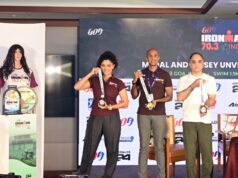Suneel Anchipaka (IAS), Director of Tourism, Goa, stated that Echoes of Earth, India’s greenest festival that celebrates its first Goa edition, adheres to the Goa Tourism Development Corporation’s (GTDC) masterplan of highlighting regenerative tourism in the state.
“Goa is the first state in India to launch a Regenerative Tourism Model. This form of tourism goes beyond sustainability – the GTDC’s masterplan emphasises responsible tourism and regenerative tourism. Under the latter’s framework, the Goa Tourism Department has been promoting several initiatives like Echoes of Earth, as the festival uses sustainable material for its infrastructural design and decor and both children and adults are educated about Goa’s forests and marine ecosystem,” stated Anchipaka at the Goa Tourism installation made out of marine plastic waste at the Echoes of Earth festival at Chopdem in North Goa.
Anchipaka also added that the festival is an amalgamation of celebration and awareness for children and adults to partake in, hence it captures all sections of people at one go.
“We want to make this festival an annual affair in Goa’s event calendar,” said Anchipaka, after which he embarked on a guided walkthrough of the festival venue, appreciating the variety of sustainable measures incorporated into the festival’s design.
The Day 2 of the festival also saw several attendees participating in activities at the Greener Side Zone, an initiative by the festival which aimed to inculcate in children and adults an understanding of the significance of Goa’s ecology and the Western Ghats through curated art, music and workshops.
The music of the day spanned across various genres, with Goan musical act Roz Angon performing at the Kraken stage, along with international artists like Tribalneed who performed for the second time after his Day 1 performance at the Jungle Stage. The highlight of the evening was the performance by musician Satori, known for creating electronic world music that incorporates earthy tones, at the Big Beak stage.
The schedule for Day 2 of the Greener Side Zone comprised the Bugs BnB Demo Workshop and Mangrove Tangram by Maria Antony, Bioscope Storytelling by Bookworm Goa, Rhythm Circle by Mac Bhatt, Animal Face Painting by Nitija Palyekar, Festival Walkthrough by Kaushalika Dharmadhikari, Photo Exhibit – ‘Ensemble of the Wild’ curated by Felis Films, WWF-India and Goa State Biodiversity Board and a Reading Cove put together by WWF-India and Echoes of Earth Journey Trail.
“Our bioscope, a portable instrument with holes through which one can see image sequences, teaches people about the importance of conservation through slow storytelling and finds immense resonance with Echoes of Earth’s commitment to sustainability and conservation,” according to Sanika Dhakephalkar and Malcolm Braganza, a visual arts instructor and project coordinator for libraries and school programmes, respectively, at Bookworm Goa.
Several children and adults partook in the face-painting activity by Palyekar, a Goan artist who dabbles in nature-based paintings.
“People love to get images of animals and plants painted on their faces and I am grateful for the platform I have been given by Echoes of Earth to showcase my artistry to the public. The greenery in and around the venue truly inspires my creativity,” said Palyekar.
Antony, a nature educator at Ashoka Trust for Research in Ecology and the Environment, Tamil Nadu, facilitated two workshops, which attracted several families and children keen to learn about the importance of the smaller and often overlooked wildlife like bees and wasps as well as mangrove ecosystems.
“The Bugs BnB Demo Workshop teaches people about the importance of making places for the natural world to thrive, especially in urban spaces. Crafted out of recycled bamboo, and utilising invasive plants to make the ‘bug hotel’ more comfortable for our ‘micro friends’, people are educated about conservation, sustainability, invasive and exotic species and microfauna in one fell swoop,” stated Antony.
According to Antony, the Mangrove Tangram (a wooden puzzle crafted from recycled plywood) teaches people about three important aspects of the mangrove systems in Goa upon completion of the puzzle – their ecological importance, the adaptability of mangroves and some basic information about the tree.
Mac Bhatt’s Rhythm Circle aimed to inculcate an appreciation of the sounds of nature among people, utilising bird whistles and percussion instruments to enable people to let their creativity soar sonically.
Dharmadhikari’s Festival Walkthrough gave attendees a nuanced understanding of the painstakingly detailed efforts put into promoting and maintaining sustainability through circular design and spreading awareness about conserving Goa’s wildlife through art installations crafted from upcycled scrap.
The festival’s second day culminated with attendees meandering through the lush green landscapes while admiring the art installations featuring a variety of Goan fauna species crafted from upcycled scrap material and experiencing locally curated Goan cuisines.






